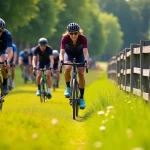Defining Diversity in Niche UK Sports
Diversity in sports refers to embracing differences in race, gender, age, ability, and background within sporting communities. In the context of niche UK sports, diversity means ensuring that these lesser-known activities are accessible and welcoming to everyone, not just traditional participants.
Inclusion definitions emphasize removing barriers that might discourage participation, such as cultural stereotypes or lack of accessible facilities. For niche sports, often enjoyed by smaller, tight-knit communities, fostering diversity is crucial to growth. A “niche” sport in the UK typically means an activity less mainstream than football or rugby, examples include ultimate frisbee, curling, or lacrosse. These sports often struggle with visibility and diversity due to limited exposure or resources.
Also to read : How Can Fostering Youth Sports Participation Impact Future Athletic Development?
Diversity benefits niche sports by enriching the culture, promoting creativity, and building stronger, more supportive communities. When participants from various backgrounds feel truly included, the sport becomes more vibrant and sustainable, offering new perspectives and increasing overall participation. Addressing diversity in these sports not only benefits athletes but also shapes a more equitable sporting environment across the UK.
Current State of Diversity in Niche UK Sports
Diversity statistics UK sports reveal that niche sports often show less varied athlete demographics compared to mainstream activities. Participation rates in sports like squash, fencing, and archery tend to involve fewer ethnic minorities and lower representation from economically disadvantaged groups. For example, recent data highlights that ethnic minority athletes make up a small fraction of participants in these disciplines, even as broader UK sports demographics become more diverse.
Also to read : How Have UK Sports Impacted Community Building?
This disparity stems partly from accessibility issues and limited outreach within underrepresented communities. In contrast, mainstream sports enjoy higher participation rates from diverse backgrounds through targeted grassroots programs and cultural popularity.
Underrepresented groups in niche UK sports include women and ethnic minorities, who frequently report barriers such as lack of role models and fewer development opportunities. These factors widen the gap in athlete demographics and participation rates. Addressing these disparities requires focused efforts on inclusion and tailored engagement strategies to boost diversity statistics UK sports currently struggle to improve.
Barriers to Inclusion in Niche Sports
Diverse participants in niche sports often face significant barriers to participation rooted in structural, cultural, and economic challenges. Access to UK sport, especially those less mainstream, is frequently hindered by limited funding and resources, which restricts entry points for underrepresented groups. For example, high equipment costs or expensive facilities can disproportionately exclude individuals from lower-income backgrounds.
Cultural barriers also play a crucial role. Many niche sports lack visible role models that reflect the diversity of potential players. This absence of representation can discourage newcomers who feel the sport is “not for people like me.” Social attitudes and stereotypes further entrench these barriers, framing certain niche sports as exclusive or unsuitable for certain ethnicities, genders, or communities.
These diversity challenges create a cycle where fewer participants from diverse backgrounds enter the sport, perpetuating the lack of inclusivity. Overcoming these issues requires targeted efforts to raise awareness, promote inclusive policies, and provide equitable access to facilities. Addressing this complex mix of barriers is essential for broadening access to UK sport and fostering diversity in all sports arenas.
Practical Strategies to Enhance Diversity
Enhancing diversity in sports requires focused efforts on inclusive outreach designed specifically for underrepresented groups. Programs that introduce sports activities in schools and community centers can effectively engage individuals who might not otherwise participate. These initiatives often include beginners’ clinics or “try-it” days, which lower barriers and invite wider participation.
Once initial engagement is secured, building training and mentorship systems is crucial. Experienced athletes and coaches can provide guidance and create an encouraging environment that fosters long-term involvement. Support networks also help address challenges related to cultural or socio-economic differences, making inclusivity tangible rather than theoretical.
Funding and scholarships play a vital role in these strategies. Financial aid helps remove economic obstacles that prevent talented individuals from accessing quality training or equipment. Grants aimed at diversity enhancement enable clubs and organizations to maintain these inclusive outreach and sports initiatives over time. Continued investment ensures that opportunities grow beyond occasional programs into sustained pathways for diverse athletes to thrive.
Policy and Governance Approaches
To foster meaningful progress in sports policy, governing bodies must introduce clear, actionable frameworks prioritizing diversity governance. These frameworks should set guidelines that actively dismantle barriers preventing underrepresented groups from participating. Effective sports policy involves transparent recruitment strategies that emphasize inclusion at all levels, from grassroots clubs to elite organizations.
Club recommendations often highlight the importance of diverse leadership, empowering decision-makers who reflect the communities they serve. This representation ensures policies remain responsive and equitable. Additionally, instituting monitoring and accountability measures is crucial. Regular audits and data collection allow governing bodies to track diversity metrics, identify gaps, and adjust strategies accordingly.
A well-implemented monitoring system promotes accountability by linking diversity goals with tangible outcomes. By integrating these components, sports organizations can create environments where all members feel welcomed and valued. Encouraging clubs to adopt these governance approaches signals a commitment to ongoing, systemic change rather than temporary fixes. This creates a sustainable model for inclusion that benefits both the sporting community and society at large.
Case Studies of Success in Niche UK Sports
Exploring diversity case studies within niche UK sports reveals inspiring stories where inclusion efforts have truly changed the game. One such successful initiative involves grassroots clubs that have actively prioritized welcoming underrepresented groups. These clubs often started by addressing barriers such as lack of awareness and perceived exclusivity.
For example, community-oriented cycling groups introduced tailored sessions for women and ethnic minorities, which resulted in a notable rise in participation over a single season. Data from these initiatives consistently show measurable impacts: increases in membership diversity, improved retention rates, and stronger local support networks.
Lessons learned emphasize the importance of sustained commitment, clear communication, and culturally sensitive programming. By embedding diversity into their core values and operations, these organisations create environments where everyone feels valued. The ripple effects extend beyond sports, fostering greater social cohesion and empowering communities.
Such UK sports inclusion successes prove that targeted strategies can overcome traditional hurdles, proving the power of diversity to enrich niche sports for all involved.
Recommendations for Promoting Diversity
Small sports clubs can implement actionable recommendations to foster more inclusive environments. First, clubs should establish clear policies that emphasize the importance of diversity and inclusion. Providing step-by-step guidance to staff and volunteers ensures consistent practices that promote representation across all levels.
Allyship plays a critical role in this process. Encouraging members to be active allies means recognizing biases and supporting underrepresented groups. Partnering with local community organizations offers valuable sports club guidance and expands outreach efforts, helping clubs connect with diverse participants.
Engaging stakeholders such as coaches, players, and parents creates a shared commitment to ongoing improvements. Regular training sessions on inclusion, combined with transparent communication, help maintain momentum. By adopting these methods, clubs not only encourage diversity but also build stronger, more cohesive teams that reflect the wider community.





